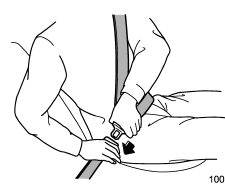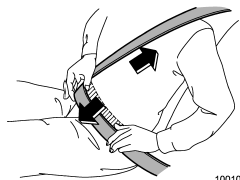Subaru Outback (BR): Front seatbelts
1. Adjust the seat position:
Driver’s seat: Adjust the seatback to the upright position. Move the seat as
far from the steering wheel as practical while still maintaining full vehicle control.
Front passenger’s seat: Adjust the seatback to the upright position. Move the seat
as far back as possible.
2. Sit well back in the seat.
3. Pick up the tongue plate and pull the belt out slowly. Do not let it get twisted.
If the belt stops before reaching the buckle, return the belt slightly and pull
it out more slowly. If the belt still cannot be unlocked, let the belt retract slightly
after giving it a strong pull, then pull it out slowly again.

4. Insert the tongue plate into the buckle until you hear a click.

5. To make the lap part tight, pull up on the shoulder belt.
6. Place the lap belt as low as possible on your hips, not on your waist.
READ NEXT:
The shoulder belt anchor height should be adjusted to the position best suited
for the driver/front passenger. Always adjust the anchor height so that the shoulder
belt passes over the middle of
Push the button on the buckle.
Before closing the door, make sure that the belts are retracted properly to avoid
catching the belt webbing in the door.
1. Sit well back in the seat.
2. Pick up the tongue plate and pull the belt out slowly. Do not let it get twisted.
If the belt stops before reaching the buckle, return the belt slightly and pull
SEE MORE:
A: REMOVAL
1. SEDAN MODEL
Rear combination light side
1) Disconnect the ground cable from battery.
2) Release the lock and remove the bulb inspection cover of trunk room trim.
3) Remove the bulb socket and tail light/stop light bulb.
Rear finisher light side
1) Disconnect the ground cable f
WARNING
When shifting down a gear, ensure that the vehicle is not travelling at a speed
exceeding the Maximum Allowable Speed for the gear which is about to be selected.
Failure to observe this precaution can lead to engine over-revving and this in turn
can result in engine damage.
In additi
© 2010-2025 Copyright www.suoutback.com




